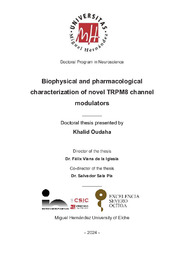Resumen :
The transient receptor melastatin 8 (TRPM8), is a polymodal nonselective cation channel activated by cold (menor o igual 28 ºC) and ligands (menthol, WS-12 and icilin). TRPM8 channel is expressed within a subpopulation of peripheral sensory neurons, where it functions as the prime physiological sensor of environmental cold. Moreover, TRPM8 is implicated in many other physiological functions such as warm perception, basal tear production, thermoregulation and energy balance. In counterpart, dysregulation of this channel is responsible for the emergence of different pathologies including dry eye disease, cold allodynia and migraine. Interestingly, either the activation of TRPM8 using agonists (for example cold, menthol, cryosim3) or blockade of the channel by antagonists (for example AMTB or BCTC) had analgesic, antipruritic, anti-inflammatory or antitumoral effects. The dual role of TRPM8 in physiological and pathological conditions highlights the need for the identification of novel TRPM8 modulators. Alongside, understanding the mechanism of the action of different modulators on TRPM8 may help to better understand both channel function and contribute to the development of more selective and potent modulators.
In this thesis, TRPM8 channel modulation by three novel agonists, as well as their mechanisms of action on TRPM8 have been studied. First, I show that mouse TRPM8 is a pharmacological target of the natural macrolide rapamycin (Sirolimus), previously known as an mTOR inhibitor. Rapamycin has been widely used in the clinic as an immunosuppressant, to prevent organ rejection during organ transplant. Moreover, more recently, the topical application of rapamycin either on the skin or in the eye has shown promising results in improving dermatitis and dry eye disease, respectively. Therefore, by combining calcium imaging and patch-clamp experiments, I demonstrate that rapamycin activates heterologously expressed mouse TRPM8 channels and sensitizes their response to cold stimuli. More specifically, rapamycin activates TRPM8 channels by inducing a leftward shift of the voltage of activation activation (V1/2) towards more negative potentials. I demonstrate that the effect of rapamycin on the TRPM8 channel is independent from the known menthol and its derivative WS-12 binding sites, and that TRP domain residues are essential for TRPM8 activation, whether induced by rapamycin or other known agonists such as cold or WS-12. In mouse DRG cultured neurons, I found, using patch-clamp recordings, that rapamycin not only elicited inward currents but also potentiated the inward current evoked by cold stimulus. Furthermore, rapamycin triggered action potential firing in TRPM8-expressing cold sensory DRG neurons. Next, following skin nerve experiments, I found that rapamycin elicits action potential firing in cold free endings innervating mouse skin by shifting the threshold towards warmer temperatures.
Secondly, I characterized the agonistic effects of two newly synthetized molecules, G-RGM-145 y G-RGM-109 on TRPM8. I demonstrated, by calcium imaging, that both agonists activate heterologously expresed mouse TRPM8 channels and potentiate cold-evoked responses. Furthermore, I found that both agonists, G-RGM-145 y G-RGM-109, share a similar mechanism of action as menthol, acting through the same biding site, Y745, located in transmembrane segment 1. In DRG cultured neurons, following calcium imagine experiments, I demonstrated that both, G-RGM-145 y G-RGM-109, selectively activate TRPM8-epressing cold sensory neurons and sensitize their cold response. Furthermore, these responses were fully abolished upon the application of TRPM8 antagonists.
In summary, these results identify TRPM8 as a molecular target of the immunosuppressant molecule rapamycin and the novel synthetic molecules G-RGM-145 y G-RGM-109, which contributes to the expansion of the arsenal of drugs targeting TRPM8.
|
 La licencia se describe como: Atribución-NonComercial-NoDerivada 4.0 Internacional.
La licencia se describe como: Atribución-NonComercial-NoDerivada 4.0 Internacional.
.png)
